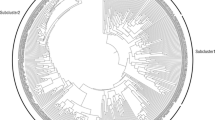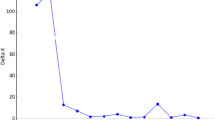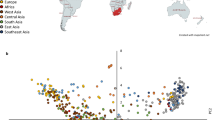Abstract
Twenty-one informative microsatellite loci were used to assess and compare the genetic diversity among Pisum genotypes sourced from within and outside China. The Chinese germplasm comprised 1243 P. sativum genotypes from 28 provinces and this was compared to 774 P. sativum genotypes that represented a globally diverse germplasm collection, as well as 103 genotypes from related Pisum species. The Chinese P. sativum germplasm was found to contain genotypes genetically distinct from the global gene pool sourced outside China. The Chinese spring type genotypes were separate from the global gene pool and from the other main Chinese gene pool of winter types. The distinct Chinese spring gene pool comprised genotypes from Inner Mongolia and Sha’anxi provinces, with those from Sha’anxi showing the greatest diversity. The other main gene pool within China included both spring types from other northern provinces and winter types from central and southern China, plus some accessions from Inner Mongolia and Sha’anxi. A core collection of Chinese landraces chosen to represent molecular diversity was compared both to the wider Chinese collection and to a geographically diverse core collection of Chinese landraces. The average gene diversity and allelic richness per locus of both the micro-satellite based core and the wider collection were similar, and greater than the geographically diverse core. The genetic diversity of P. sativum within China appears to be quite different to that detected in the global gene pool, including the presence of several rare alleles, and may be a useful source of allelic variation for both major gene and quantitative traits.


Similar content being viewed by others
References
Ambrose MJ (1995) From Near East Center of Origin, the prized pea migrates throughout the world. Diversity 11:118
Baranger AG, Aubert G, Arnau G, Lainé AL, Deniot G, Potier J, Weinachter C, Lejeune-Hénaut J, Lallemand J, Burstin J (2004) Genetic diversity within Pisum sativum using protein- and PCR-based markers. Theor Appl Genet 108:1309–1321
Burstin J, Deniot G, Potier J, Weinachter C, Aubert G, Baranger A (2001) Microsatellite polymorphism in Pisum sativum. Plant Breed 120:311–317
Choudhury PR, Tanveer H, Dixit GP (2007) Identification and detection of genetic relatedness among important varieties of pea (Pisum sativum L.) grown in India. Genetica. doi:10.1007/s10709-006-9005-9
Ellis THN, Poyser SJ, Knox MR, Vershinin AV, Ambrose MJ (1998) Polymorphism of insertion sites of Ty1-copia class retrotransposons and its use for linkage and diversity analysis in pea. Mol Gen Genet 260:9–19
Erskine W (1997) Lessons for breeders from land races of lentil. Euphytica 93:107–112
Erskine W, Muehlbauer FJ (1991) Allozyme and morphological variability, outcrossing rate and core collection formation in lentil germplasm. Theor Appl Genet 83:119–125
Erskine W, Chandra S, Chaudhry M, Malik IA, Sarker A, Sharma B, Tufail M, Tyagi MC (1998) A bottleneck in lentil: widening its genetic base in South Asia. Euphytica 101:207–211
Ferguson ME, Ford-Lloyd BV, Robertson LD, Maxted N, Newbury HJ (1998a) Mapping the geographical distribution of genetic variation in the genus Lens for the enhanced conservation of plant genetic diversity. Mol Ecol 7:1743–1755
Ferguson ME, Robertson LD, Ford-Lloyd BV, Newbury HJ, Maxted N (1998b) Contrasting genetic variation amongst lentil landraces from different geographical origins. Euphytica 102:265–273
Ford R, Le Roux K, Itman C, Brouwer JB, Taylor PWJ (2002) Genome-specific sequence tagged microsatellite site (STMS) markers for diversity analysis and genotyping in Pisum species. Euphytica 124:397–405
Frankel OH, Brown AHD (1984) Current plant genetic resources—a critical appraisal. In: Genetics: new Frontiers, vol IV. Oxford and IBH Publ. Co., New Delhi
Fuentes-Davila G, Rajaram S, Singh G (1995) Inheritance of resistance to karnal bunt (Tilletia indica Mitra) in bread wheat (Triticum aestivum L.). Plant Breed 114:250–252
Goudet J (1995) FSTAT (ver. 1.2): a computer program to calculate F-statistics. J Hered 86:485–486
International Center for Agricultural Research in the Dry Areas (2001) Annual report 2001
Islam F, Beebe S, Munoz M, Tohme J, Redden RJ, Basford KE (2004) Using molecular markers to assess the effect of introgression on quantitative attributes of common bean in the Andean gene pool. Theor Appl Genet 108:243–252
Keneni G, Jarso M, Wolabu T, Dino G (2005) Extent and pattern of genetic diversity for morpho-agronomic traits in Ethiopian highland pulse landraces: 1. Field pea (Pisum sativum L.). Genet Res Crop Evol 52:539–549
Kimura M, Crow JF (1964) The number of alleles that can be maintained in a finite population. Genetics 49:725–738
Lewontin RC (1972) The apportionment of human diversity. Evol Biol 6:381–398
Lu J, Knox MR, Ambrose MJ, Brown JKM, Ellis THN (1996) Comparative analysis of genetic diversity in pea assessed by RFLP- and PCR-based methods. Theor Appl Genet 93:1103–1111
Matthews P, Ambrose MJ (1995) Development and use of a “core” collection for the John Innes Pisum Collection. In: Proceedings of 2nd European conference on grain legumes, Copenhagen, Denmark, pp 194–195
Pearce SR, Knox M, Ellis THN, Flavell AJ, Kumar A (2000) Pea Ty1-copia group retrotransposons: transpositional activity and use as markers to study genetic diversity in Pisum. Molec Gen Genet 263:898–907
Pilet-Nayel L, Muehlbauer FJ, McGee RJ, Kraft JM, Baranger A, Coyne CJ (2002) Quantitative trait loci for partial resistance to Aphanomyces root rot in pea. Theor Appl Genet 106:28–39
Smouse PE, Peakall R (1999) Spatial autocorrelation analysis of individual multiallele and multilocus genetic structure. Heredity 82:561–573
Rajaram S (1999) Approaches for breaching yield stagnation in wheat. Genome 42:629–634
Redden B, Leonforte T, Ford R, Croser J, Slattery J (2005) Pea (Pisum sativum L.). In: Singh RJ, Jauhar PP (eds) Genetic resources, chromosome engineering, and crop improvement. Grain legumes, vol 1, Chap. 3. CRC Press, Boca Raton, pp 49–83
Rohlf F (2006) NTSYSpc: numerical taxonomy system (ver. 2.2). Exeter Publishing, Ltd., Setauket
Taylor PWJ, Fraser TA, Ko H-L, Henry R (1995) RAPD analysis of sugarcane during tissue culture. In: Terzi M, Cella R, Falavigan A (eds) Current issues in plant molecular and cellular biology. Kluwer Academic Int, Dordrecht, pp 241–246
Tohme J, Jones P, Beebe S, Iwanaga M (1995) The combined use of agroecological and characterization data to establish the CIAT Phaseolus vulgaris core collection. In: Hodgkin T, Brown AHD, van Hintum TJL, Morales EAV (eds) Core collections genetic resources. Wiley, Chichester, pp 95–107
Tohme J, Gonzales OD, Beebe S, Duque MC (1996) AFLP analysis of gene pools of a wild bean core collection. Crop Sci 36:1375–1384
Van Hintum TJL (1999) The general methodology for creating a core collection. In: Johnson RC, Hodgkin T (eds) Core collections for today and tomorrow. International Plant Genetic Resources Institute, Rome, pp 10–17
Yadav VK, Kumar S, Panwar RK (2007) Measurement of genetic dissimilarity in fieldpea (Pisum sativum L.) genotypes using RAPD markers. Genet Res Crop Evol. doi:10.1007/s10722-006-9109-1
Yeh FC, Boyle TBJ (1997) POPGENE Microsoft Windows-based software for population genetic analysis. A joint project development by Francis C. Yeh, University of Alberta and Tim Boyle, Center for International Forestry Research, Bogor, Indonesia, 29 p
Zohary D (1973) The origin of cultivated cereals and pulses in the Near East. In: Wahrman J, Lewis KR (eds) Chromosomes today, vol 4. Wiley, New York, pp 307–320
Zohary D (1999) Monophyletic vs. polyphyletic origin of the crops on which agriculture was founded in the Near East. Genet Res Crop Evol 46:133–142
Acknowledgments
The funding received within the Australian Center for International Agricultural Research project CS1/2000/035 is gratefully acknowledged.
Author information
Authors and Affiliations
Corresponding author
Additional information
Communicated by M. Morgante.
Electronic supplementary material
Below is the link to the electronic supplementary material.
Rights and permissions
About this article
Cite this article
Zong, X., Redden, R.J., Liu, Q. et al. Analysis of a diverse global Pisum sp. collection and comparison to a Chinese local P. sativum collection with microsatellite markers. Theor Appl Genet 118, 193–204 (2009). https://doi.org/10.1007/s00122-008-0887-z
Received:
Accepted:
Published:
Issue Date:
DOI: https://doi.org/10.1007/s00122-008-0887-z




